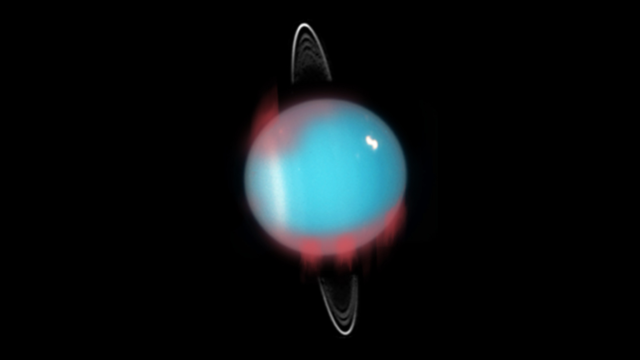Feast your eyes on Uranus’ glowing edges. We’re serious—a team of astronomers has spotted a new aurora on the seventh planet from the Sun, glowing at infrared wavelengths.
Ultraviolet aurorae were first spotted on the planet in 1986, but an infrared aurora had never been seen before. The aurora’s discovery was made with the Keck II Telescope’s Near-Infrared Spectrograph (NIRSPEC) and reported in Nature Astronomy. The observations were actually made in September 2006, but new analysis of the ion H3+ detected in the data revealed the aurora’s presence.
“This paper is the culmination of 30 years of auroral study at Uranus, which has finally revealed the infrared aurora and begun a new age of aurora investigations at the planet,” said Emma Thomas, an astronomer at the University of Leicester and the study’s lead author, in a university release. “Our results will go on to broaden our knowledge of ice giant auroras and strengthen our understanding of planetary magnetic fields in our solar system, at exoplanets and even our own planet.”
Uranus is an ice giant about four times the size of Earth. It has nearly 30 moons, the largest of which may have ocean layers, ripe for astrobiological inquiry. But the world itself is also of scientific value; an astronomy report released last year declared that a probe to Uranus should be “the highest priority large mission” of the next decade.
The newly spotted aurora is one of several new developments spotted on Uranus this year alone. In April, the $US10 billion Webb Space Telescope imaged the planet’s dusty rings—tough to spot in older space telescope imagery but clear as day to Webb’s perceptive gaze. Hubble images published in March 2023 showed how the planet’s rotational axis had shifted, tilting Uranus’ north pole toward the Sun.
Aurorae on Uranus are caused by the same type of interaction as on Earth; charged particles interact with planets’ atmospheres by way of their magnetic fields, emitting a luminous glow across visible light wavelengths as well as, in Uranus’ case, infrared and ultraviolet. The researchers believe studying Uranus’ aurora could improve our understanding of the planet’s atmosphere and the way its poles change locations.
“We don’t have many studies on this phenomena and hence do not know what effects this will have on systems that rely on Earth’s magnetic field such as satellites, communications and navigation,” Thomas added. “However, this process occurs every day at Uranus due to the unique misalignment of the rotational and magnetic axes. Continued study of Uranus’s aurora will provide data on what we can expect when Earth exhibits a future pole reversal and what that will mean for its magnetic field.”
The Uranus probe recommended by the 2022 decadal survey of astronomy goals would map the planet’s gravitational and magnetic fields, the latter of which are responsible for the recently observed aurora. But, should such a probe become a reality, it likely won’t launch until 2031 or 2032, to capitalize on a gravitational assist from Jupiter on its way to the more distant icy planet.
